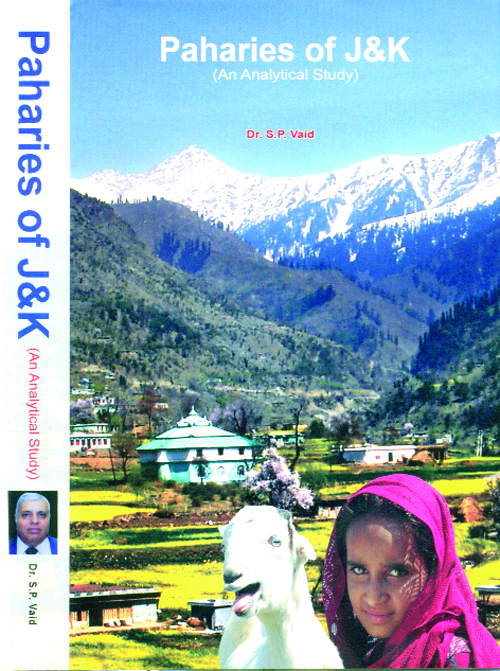Avtar Bhat
Name of the book : Paharies of J&K (an analytical study)
Author: : Dr S P Vaid
Price : Rs 850
Name of Publishing : Shyama Publications
House Jammu, 85 Subash Nagar, Jammu
Dr S P Vaid’s recent book Paharies in J&K throws light on the Pahari culture, the way of life of Pahari people, their language, traditions etc. Going through the pages of the book one comes to know that the author had made an independent study on life and history of Pahari people in erstwhile J&K State. While going through the book one will find that it has both the depth and profundity and one may go through it both for pleasure and profit. The book is totally based on research over the life and history of Pahari people in the State. It is sanguine that this book will go a long way to prove useful for further research on the subject as it can provide the necessary historical material to those students, teachers and scholars who have the urge and propensity to evaluate the events and the happenings that overtook the people of the region in the last century.
The book hence will be very useful for researchers and can be used as a reference book by them as it is with a vast source of information on the pahari people. Indeed the author has made an unique attempt to make available the vast source of information which usually is not available for the people who are interested to study the history, culture and Pahari traditions in depth.
Dr Vaid a versatile writer has nine books to his credit which included How Partition Rocked J&K , Socio-economic Roots of Unrest in Jammu and Kashmir 1931-47, Tourist Destination in India, Derailing of youth from main stream, causes and remedies, Exams, jobs, Career &Burning Environmental issues, Bichhode-Ki-Peeda (an Autobiography in Hindi), judaee-ka_Dard(an Autobiography in Udu), Pangs of Separation (an Autobiography in English) and Jammu Kashmir ke Pahari Log Ake Ake Tajziat Mutalia in Urdu. The Paharies of J&K is his latest book.
The author has quoted historical and official references to substantiate facts and figures given in the book to make it more relevant and authentic for students of research. As already mentioned the author who has made an indepth research on life, history, culture, language and traditions as well as their way of life states that the districts of Muzaffarabad, now in Pakistan, Reasi and Udhampur and Jagir of Poonch fall predominantly under the influence of Paharies. The numbers of Pahari speaking people in 1931 were 5, 95,754 against 5, 36,069 as per census of 1921.
The book states that despite having different religion, their linguistic communications, customs, traditions, and sharing of their festivals is common. The book while terming Pahari society as an Ethnic Group reveals that Pahari society has a composite culture in areas inhibited by it. The Pahari society has a distinct style of living, separate dress, food habits, folk songs and traditions. Both Paharies and Gujjars are ethnic, linguistic and cultural entities who possess similar racial and cultural characteristics. Their dresses are generally common like Shalwar -Kameez and turbans with a waist court and a blanket on their shoulders so that one can’t differentiate between a Pahari and a Gujjar walking together. Not only this but their customs marriage, rituals, and traditions are the same.
The author has touched the every sphere of Paharies life. While referring to their physical features he states that the Paharies are generally handsome, courteous and enthusiastic. They are also laborious, dauntless and hospitable. Besides they are soft spoken, upright and self respecting people who have no match in hospitability.
Referring to their food habits, the book reveals that the maize is the staple food for Paharies including Gujjars and Bakkerwals. The Makki -Roti is cooked in earthen huge cooking place called Tandoor or Oven and mostly it is cooked on iron pot. Maintaing that most Pahari people are poor the author says they can’t afford rice which is available at certain places.
The book says Paharies are mostly superstitious and have become victims of evil spirits and these dogmas are quite common among both the Muslims and Hindu communities. Their customs are mostly common showing unity in diversity. These customs prevail in them from birth to death and from cradle to grave, reveals the book.
Besides the book is an initiative taken by the author after being emboldened and encouraged through the project allotted by University Grants Commission (U.G.C) in the capacity of Emeritus-Fellowship of this prestigious national mission. It deals with the origin of the Paharies, their Historical background, the Pahari society, life style of Gujjars and Bakkerwals as well as with Gaddies and Sippies, Duggar-Desh society, Kashmiri society , property and laws of inheritance, Riwaj-i-Aam, economy, occupation and changing life style of the Paharies and last but not the least the present demands of the Paharies. It also highlights the artificial division of Jammu and Kashmir state migration of masses from both sides, role of social organisations and political movements as they developed over the years. The author has tried to champion their cause as well. He has tried his best to make the book very informative after consulting virtually all sources and resources that are available on this side of the border in the form of official records reports memoirs interaction with well meaning and well knowledgeable personalities of the State to make it authentic. About the Author: The author who was born in village Gunni, tehsil Kotli, ditrict Mirpur now in PoK is a doctorate in History from Jammu University. He has served Education Department for decades together and is the recipient of the State and National Awards in the year 1995 and 1996. He was also honoured with Mohyal Gaurav Smmsn in 1998 and Rashtriya Gaurav Award in 2004.


